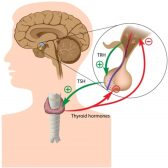Definition
noun, plural: amniotic sacs
Fluid-filled sac where the embryo or fetus is suspended in the uterus or in the of the amniotes
Supplement
One of the distinctive features of the amniotes is producing an embryo that develops in an amnion and chorion and has an allantois. Some of the amniotes, such as reptiles and birds, lay eggs on land while others, such as mammals, retain the fertilized egg within the uterus and give birth to a living young. This feature is in contrast to the anamniotes such as fish and amphibians that lay eggs in water. The name, amniotes, is associated with the membrane, particularly amnion, from where the embryo or fetus develops. Other membranes present during embryonic or fetal development are chorion, allantois, and umbilical vesicle.
The amniotic sac is the sac filled with amniotic fluid. The fluid surrounds the developing embryo or fetus. The sac is a thin, transparent, and tough membrane and is also referred to as the bag of waters. In mammals, the amniotic sac normally and spontaneously breaks at full term during or at the beginning of labor. The amniotic sac, together with the placenta and the umbilical cord, is pushed out at birth after the baby is delivered.
The amniotic sac filled with amniotic fluid helps provide a liquid that cushions the developing offspring.
Also called:
- bag of waters
- membranes
See also:







